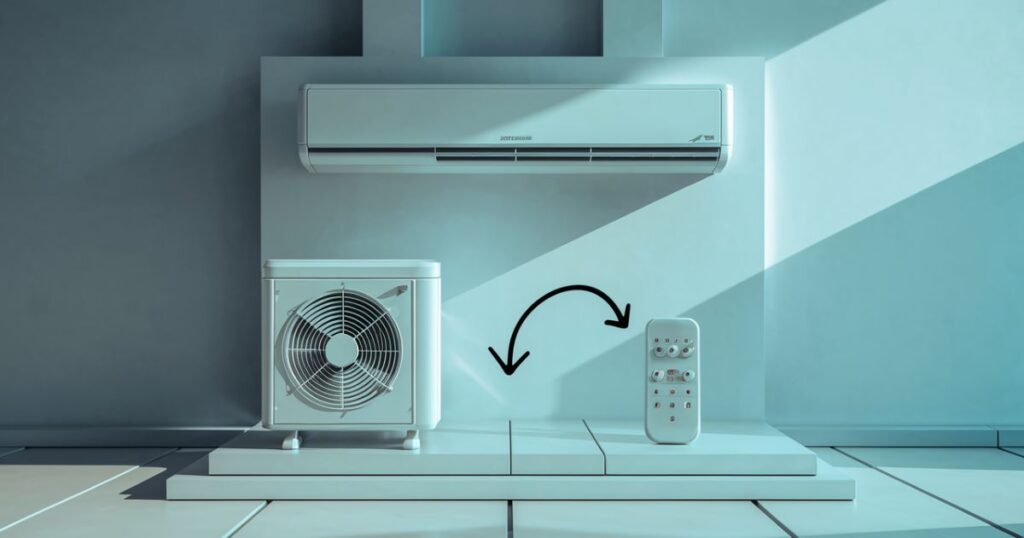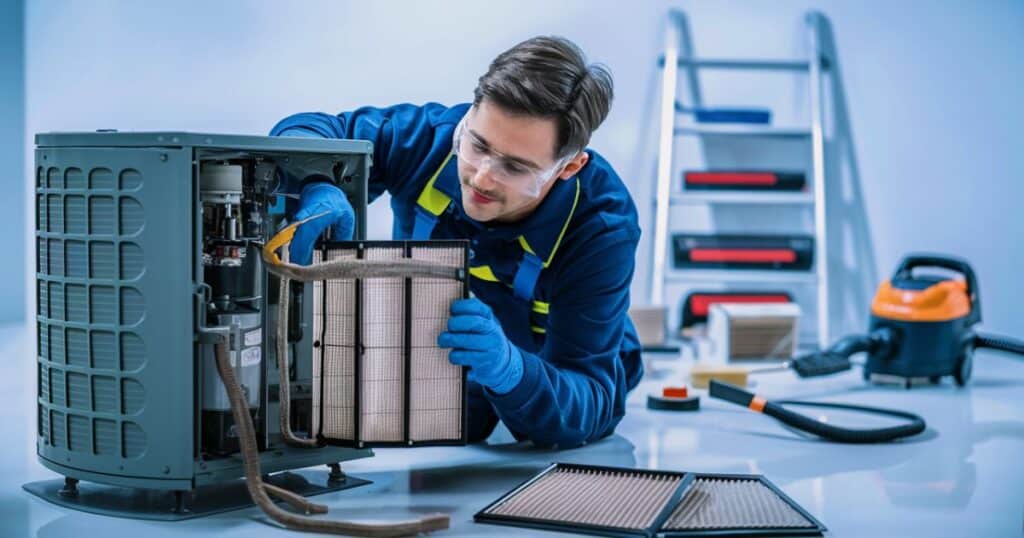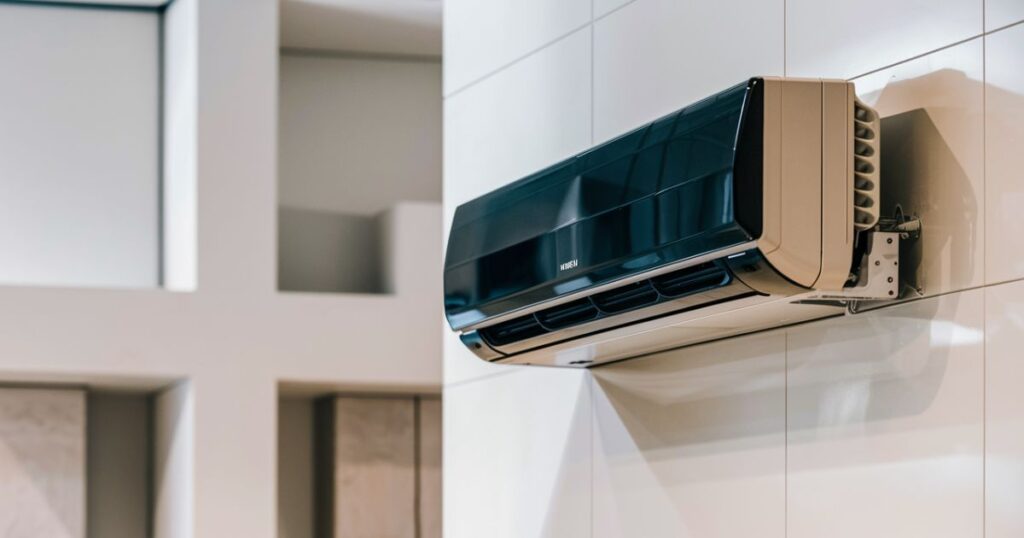Ductless mini-splits offer efficient heating and cooling. They don’t require ductwork. Installation is simpler and less invasive. Mini-splits allow zone control, saving energy. They’re quieter than traditional HVAC systems. Indoor units blend seamlessly with décor. Mini-splits are ideal for older homes lacking ducts.
They provide consistent temperature throughout spaces. Energy savings are significant with mini-splits. They offer both heating and cooling functions. Maintenance is relatively low. Mini-splits enhance indoor air quality. They’re eco-friendly and use less energy. Overall, ductless mini-splits offer comfort, convenience, and cost savings.
How Ductless Mini-Split Systems Work
Ductless mini-split systems work by using two main components: an outdoor compressor unit and one or more indoor air-handling units. The outdoor unit pumps refrigerant through lines to the indoor units, where it absorbs heat or releases it, depending on the mode. Each indoor unit is controlled independently, allowing for customizable temperature settings in different areas of the home.
These systems don’t need ducts, which reduces energy loss often associated with traditional HVAC systems. Instead, they use small conduits to connect indoor and outdoor units, making installation easier and more versatile, especially in spaces where ductwork is impractical.
Inside the indoor units, a fan blows air over coils filled with refrigerant. In cooling mode, the refrigerant absorbs heat from indoor air, cooling it down before circulating it back into the room. In heating mode, the process is reversed: the refrigerant absorbs heat from outdoor air and releases it inside.
This efficient process ensures consistent comfort year-round. With their flexibility, ductless mini-splits provide targeted heating and cooling, making them an excellent choice for homes with specific temperature needs in different areas. Their energy-efficient design helps save on utility bills while minimizing environmental impact.
Benefits of Ductless Mini-Split Heating and Cooling Systems
Ductless mini-split heating and cooling systems offer numerous advantages for homeowners and businesses alike. These systems operate without ductwork, which eliminates energy loss and improves efficiency.
Here are some key benefits:
- Energy Efficiency: Ductless mini-splits are highly energy-efficient, as they don’t suffer from the energy loss associated with ductwork.
- Customized Comfort: With zone control capabilities, mini-splits allow different areas of a building to be heated or cooled independently, providing personalized comfort.
- Easy Installation: Installation is simpler compared to traditional HVAC systems, requiring only a small hole for conduit installation.
- Quiet Operation: Indoor units of mini-split systems operate quietly, ensuring minimal disturbance to occupants.
- Enhanced Aesthetics: Indoor units are sleek and compact, blending seamlessly into any room’s décor without compromising aesthetics.
- Cost Savings: By reducing energy consumption and offering zone control, mini-split systems help lower utility bills over time.

These benefits make ductless mini-split heating and cooling systems an attractive option for those seeking efficient, customizable, and cost-effective climate control solutions.
Disadvantages of Ductless Mini-Splits
Ductless mini-split systems offer efficient heating and cooling without ductwork, providing customized comfort and easy installation. However, they also have some disadvantages:
| Disadvantages | Description |
| Initial Cost | Ductless mini-split systems can have higher upfront costs compared to traditional HVAC systems. |
| Regular Maintenance | Maintenance and cleaning of indoor units may be required more frequently than with central HVAC. |
| Aesthetics | While indoor units are discreet, the presence of multiple units may not suit every aesthetic. |
| Limited Coverage | Mini-splits are generally suitable for smaller areas, making them less ideal for larger spaces. |
| Noise Levels | Despite being quieter than some systems, indoor units can still produce noticeable noise. |
Cost Comparison: Mini-Split vs. Central Air Systems
When comparing the costs of mini-split systems versus central air systems, several factors should be considered. Mini-split systems typically have lower installation costs due to their simplicity and lack of ductwork.
The initial equipment costs for mini-split units may be higher per unit compared to central air systems. Additionally, the overall cost of operation, including energy efficiency and maintenance, should be taken into account.
Here’s a breakdown in a table format:
| Cost Comparison | Mini-Split Systems | Central Air Systems |
| Installation Costs | Generally lower due to simplified installation | Higher due to ductwork installation |
| Equipment Costs | Potentially higher per unit | Lower per unit cost, but more units needed |
| Operating Costs | Can be lower due to energy efficiency | This may be higher due to ductwork inefficiency |
| Maintenance Costs | Usually lower due to fewer components | This may be higher due to ductwork inefficiency |
| Overall Cost Consideration | Initial savings may be offset by higher unit costs and potential efficiency differences | Lower installation costs may be offset by higher operating and maintenance costs |
Assessing the Investment Value of Mini-Split Systems
Assessing the investment value of mini-split systems is crucial for homeowners considering heating and cooling options. These systems offer efficient heating and cooling in individual rooms, allowing for personalized comfort. With their energy-saving features, mini-split systems can lead to reduced utility bills over time.
Mini-split systems are relatively easy to install compared to traditional HVAC systems, saving homeowners both time and money on installation costs. Their compact size and versatility make them suitable for a variety of spaces, from small apartments to larger homes. Investing in a mini-split system can enhance the overall value and comfort of a property.
Mini-split systems typically have longer lifespans and require less maintenance than other heating and cooling options. This means fewer disruptions and expenses for homeowners in the long run. By carefully assessing the investment value of mini-split systems, individuals can make informed decisions that align with their budget and comfort needs, ultimately enhancing their living experience.
Also Read This Blog: 5 Walmart Tiny Homes To Make Your Dreams A Big Reality
Maintenance Tips for Optimal Mini-Split Performance
Maintaining your mini-split system is essential for keeping it running smoothly. One important tip is to regularly clean or replace the air filters. Dirty filters can restrict airflow and decrease efficiency, so make sure to check them every month and clean or replace them as needed. Additionally, keep the outdoor unit free of debris like leaves and branches to ensure proper airflow and prevent any potential damage.

Another important maintenance tip is to schedule professional inspections and tune-ups at least once a year. A trained technician can inspect the system for any issues, clean the coils, and check refrigerant levels to keep your mini-split performing optimally. Regular maintenance helps prevent costly repairs and ensures that your system continues to provide efficient heating and cooling for years to come.
Expert Guidance: Choosing the Right Mini-Split System
Choosing the right mini-split system is important for your comfort and energy efficiency. Consider factors like the size of the space you need to heat or cool and your budget. Look for energy-efficient models with high SEER (Seasonal Energy Efficiency Ratio) ratings to save on utility bills.
- Determine the size of the space you want to heat or cool.
- Consider your budget for purchasing and installing the mini-split system.
- Look for energy-efficient models with high SEER ratings.
- Evaluate additional features such as programmable thermostats and remote controls.
- Seek expert advice from HVAC professionals to ensure you select the right system for your needs.
- Compare warranties and service agreements offered by different manufacturers.
- Take into account noise levels and aesthetics to ensure the system fits seamlessly into your space.
Debunking Common Myths About Ductless Mini-Split Systems
Debunking common myths about ductless mini-split systems helps homeowners make informed decisions about their HVAC options. One myth is that mini-splits are only suitable for cooling, but they provide both heating and cooling functions efficiently. Another misconception is that mini-splits are noisy, but modern models are designed to operate quietly, enhancing indoor comfort without disruption.
Some believe that ductless mini-split systems are expensive to install and maintain. Installation costs can be lower than traditional HVAC systems, especially in homes without existing ductwork. With proper maintenance, mini-split systems can offer long-term energy savings and reliability, making them a cost-effective choice for many homeowners. By dispelling these myths, homeowners can discover the true benefits of ductless mini-split systems for their homes.
Ductless Mini Split Air Conditioner Lowe’s
Ductless Mini Split Air Conditioner Lowe’s refers to a type of air conditioning system that doesn’t require ductwork for installation, and it’s available at Lowe’s, a popular home improvement retailer. These systems are efficient for cooling or heating individual rooms or zones in a house without the need for extensive ductwork.
At Lowe’s, customers can find a variety of ductless mini-split air conditioners from different brands, offering options to suit various needs and budgets. Whether for cooling a single room or providing climate control for an entire home, ductless mini-split air conditioners from Lowe’s offer convenience and flexibility for homeowners looking to enhance their indoor comfort.
Ductless air conditioner
A ductless air conditioner is a type of cooling system that operates without the need for ductwork. Unlike traditional central air conditioning systems that rely on ducts to distribute air throughout a building, ductless air conditioners use individual air handlers mounted on walls or ceilings to deliver cool air directly into specific rooms or zones.
These systems consist of an outdoor unit connected to one or more indoor units, allowing for personalized temperature control in different areas of a home or building. Ductless air conditioners offer advantages such as energy efficiency, quiet operation, and installation flexibility, making them a popular choice for both residential and commercial applications.
Frequently Asked Questions
What are the disadvantages of a mini-split system?
Mini-split systems may have higher upfront costs compared to traditional systems. Additionally, some homeowners may find the appearance of the indoor unit less appealing.
Can I heat my house with mini splits?
Yes, mini splits are designed to provide both heating and cooling functions efficiently, making them suitable for heating your house.
Are ductless mini splits effective?
Yes, ductless mini splits are effective for providing heating and cooling to specific areas or rooms in a house. They offer personalized comfort and energy savings.
What is the disadvantage of mini-split?
One disadvantage of mini-splits is that they may require professional installation, which can add to the overall cost.
How long do ductless mini-splits last?
Ductless mini splits can last for around 10 to 20 years with proper maintenance, depending on factors like usage and environmental conditions.
Can a ductless mini-split cool an entire house?
Yes, a ductless mini split can cool an entire house by installing multiple indoor units strategically throughout the different areas, providing zoned cooling for optimal comfort.
Conclusion
Ductless mini-split systems offer numerous benefits for homeowners seeking efficient heating and cooling solutions. They provide both heating and cooling functions, making them versatile for year-round comfort.
Despite some misconceptions, such as high installation costs and limited effectiveness, ductless mini-splits are cost-effective in the long run and can effectively cool or heat specific areas or rooms in a house. With their energy efficiency, quiet operation, and installation flexibility, ductless mini-splits prove to be a reliable and convenient option for enhancing indoor comfort while saving on energy bills.
Embracing the truth about ductless mini-splits can empower homeowners to make informed decisions about their HVAC needs, ultimately improving their living environment and quality of life.

Warner Clips is an expert writer with 4 years of experience crafting engaging content on Home topics. My expertise ranges from creating cozy environments to tackling Home Improvement projects. Find my work in publications like Huffington Post and Reader’s Digest.







